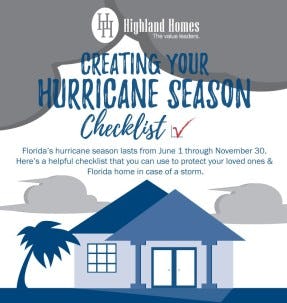Hurricane Preparedness: Create Your Florida Hurricane Checklist

Updated on September 24, 2024: This story was originally published on June 5, 2020, and has been updated with new information.
Hurricane season is officially here - The hurricane season began on June 1 and lasts through November 30, with the peak of the season typically between mid-August and mid-October. Most Floridians know the precautions that need to be taken and the level of preparedness that owning a home in Florida requires during hurricane season. But, if you’re new to our state, a first-time homeowner, or just in need of a refresher so you don’t forget any important items, we’ve provided this thorough list of hurricane preparedness tips for you.
Whether you live in a coastal city such as Tampa, Bradenton, or Sarasota, or own a new home in Central Florida in a city such as Lakeland, Davenport, or St. Cloud, keep in mind the devastating effects of a hurricane can often be felt hundreds of miles away from the coast. Ensuring your home is prepared to take on whipping winds, heavy downpours, flooding, and even power outages is key to being prepared for Florida’s hurricane season.
Know Your Terms
A tropical depression does not have the same impact as a category 1 hurricane. Knowing and understanding what your meteorologist is saying, will help you prepare for what’s ahead. A tropical depression has maximum winds of less than 39 mph, while tropical storms have winds that range from 39-73 mph, and a category 1 hurricane has winds of 74-95 mph with minimal damage potential. The eye of the storm is the center of the spiral, and the bands are the lines of thunderstorms and clouds pulling into the center of the storm.
While these are some of the basics for you to know, StormGeo.com expands these definitions, the 5-category rating system, and explains what’s really going on in the eye of the storm.
Have a Plan
Your emergency preparedness plan is something everyone in your household should be actively involved in, and should know what their role is in an emergency. In addition, make sure you share your plan with at least one remote friend or relative who wouldn’t be affected by the storm. They can serve as a central point of contact for everyone.
A complete emergency preparedness plan includes more than just your actions once a storm hits. It should include the full plan to prepare your Florida home for the approaching storm, what your household procedures will be for evacuation or staying safe at home and how to decide which course of action to take, and what to do if a storm hits unexpectedly or if you’re caught at home in its aftermath.
Make sure your preparedness plan includes:
- Contact information and important records for every person residing in your home – pets included!
- An emergency kit for each household member with relevant to you items including:
- Clean clothes and shoes,
- Prescription medicines
- Food, collars, and leashes for your pets,
- Flashlights, extra batteries, snacks, and water
- Other items you might need when away from home to leave home
Additional details and tips on making a preparedness plan, as well as printable, customizable family emergency plans for parents, kids, and pets, are available on the Ready.gov website.
Prepare Your Home
Once the alert goes out that a storm is forming and your area is listed as a potential target, it’s time to start to prepare your home for a hurricane.
- Protect your windows and glass doors
- Permanent storm shutters are the best protection
- A lower-cost approach is to pre-cut and drill plywood panels
- Label the panels so you know which panels are for which windows and have holes pre-drilled in the exterior walls for easy installation.
- Trim your trees and dispose of yard debris
- Remove any weak or dead trees or limbs near your home
- Trim any limbs overhanging your home
- Clear any tree debris from your yard
- Check for and reinforce any loose roof tiles or shingles
- Clear any debris from your gutters and make sure they’re securely attached to help prevent clogging and potential water damage to your home
- Remove all outdoor items - yard decorations, patio furniture, grills, garbage cans, etc. - to an indoor location
- Consider moving indoor furniture away from windows or cover it with protective tarps or plastic
- If your home has a second level, also consider moving items upstairs
- Back up computers and devices in case of loss to external hard drives or the cloud via Dropbox or Google Drive.
- Take inventory of the contents in your home.
- Prepare an inventory list of items in your home
- Consider recording or photographing each room, as well as valuables, in case it’s needed for future reference.
- Store important documents such as inventory lists, vehicle titles, mortgage documents, birth certificates, etc. in waterproof containers
- Turn the fridge and freezer to the coldest settings
- According to foodsafety.gov, a refrigerator will keep food cold for about 4 hours if the door is left closed and a full freezer will hold its temperature for about 48 hours
- If power is lost, turn off major appliances to reduce power surge when electricity is restored
To Leave or Not to Leave
Deciding to stay home and ride out a storm or to evacuate and leave your beloved home is tough. First and foremost, listen to your local and national officials and their directions during a storm. As difficult as it may be, if they’re telling you to evacuate, it’s important to heed the warning.
If you are faced with a mandatory evacuation or you voluntarily decide to leave with your family, it’s important to know and be familiar with the standard evacuation route for your area. Part of your hurricane preparedness plan should include a planned destination. How far will you need to go to be out of the storm’s path? Do you have family or friends within driving distance that you can stay with in case of a storm? Or, are you headed to a hotel, rental, or storm shelter? If headed for a shelter, make sure to check availability and any pet guidelines - Floridadisaster.org has helpful shelter links by county.
Build a Hurricane Kit
If you can safely stay at home during a storm, it’s imperative that you are prepared for possible power, water, internet, and cell service disruptions for several days. Many businesses are often closed, and roads can become impassible for an extended period. Ensure you can remain self-sufficient for days at a time and keep a well-stocked in-house emergency kit, with some or potentially all of the following.
Basic Supplies
- Generator, with extra fuel
- Be sure to become familiar with generator safety, such as keeping your generator outside due to the risk of carbon monoxide poisoning
- Cell phone, with a full charge
- Plus a fully-charged portable charger, if available
- Battery-powered emergency radio
- Basic toolbox with wrench or pliers to turn off the water in the event of burst pipes
- Flashlights for everyone in your household
- With extra batteries
- Maps of your local area
- Moist towelettes, garbage bags, and plastic ties for sanitation
- Basic camping supplies
- Blankets, matches, etc.
- Whistle to signal for help if needed
- Important documents in a waterproof container
- IDs, social security cards, insurance documents, etc.
- Extra clothes, shoes, and rain gear
- Dust mask to shield your lungs from any post-storm debris
Food and Water
- Water, water, and more water – the standard is one gallon per person per day, for 3 to 7 days
- Bottled juice
- Coolers filled with ice and ready if needed
- Nonperishable food - a 3 to 7-day supply
- Can opener
- Eating supplies, such as plates and forks
Medical Supplies
- First aid kit
- Bandages
- Adhesive tape
- Antiseptic solution
- Medic-alert tags
- Insect-repellent sprays
- Sunscreen
- Hygiene items
- Medications
- Baby items - medicines, soaps, thermometer, etc.
Pet Care
- Water - a 3 to 7-day supply
- Food - a 3 to 7-day supply
- Up-to-date vaccination and medical records
- Any medications, including heartworm preventatives
- Collar and leash
- Favorite toy
- Blanket or pillow
- Calming aids
- Carrier
To view a detailed emergency kit checklist, visit Ready.gov.
Additional Resources
For a full list of resources and disaster help available to Florida homeowners and residents, including shelter locations, additional preparedness plans, and links to local emergency management agencies, visit FloridaDisaster.org. Also, visit FEMA.gov or NOAA for additional assistance with hurricane preparedness, emergency alerts, and recovery operations.
As a Florida homebuilder with more than 25 years of experience building quality new homes in Tampa Bay, Bradenton-Sarasota, Lakeland-Winter Haven, Ocala, and Metro Orlando, we understand the effects of Florida’s hurricane season on residents and homeowners. Our homes are built to meet or exceed the latest building codes to help protect you and everyone in your household, as well as your home, in case of a storm. Preparing for a storm is the best way you can protect yourself, your loved ones, and your home to ensure you can enjoy it for years to come.
To learn more about our company and our dedication to building quality-built new homes designed with you and your loved ones in mind, visit our About Us page.
Tags: Hurricane Preparedness First Time Homebuyer Info Maintenance Tips Home Organization
Article Search
Categories
- Communities (147)
- - Aviary at Rutland Ranch (8)
- - Bennah Oaks (2)
- - Bentley North (3)
- - Bradbury Creek (1)
- - Bridgeport Lakes (7)
- - Copperleaf (3)
- - Cypress Ridge Ranch (2)
- - Enclave at Lake Myrtle (3)
- - Falls of Ocala (4)
- - Gardens at Lancaster Park (3)
- - Geneva Landings (4)
- - Gracelyn Grove (5)
- - Hammock Reserve (2)
- - Harbor at Lake Henry (3)
- - Jackson Crossing (4)
- - Lakeside Preserve (3)
- - Otter Woods Estates (2)
- - Ridgewood (7)
- - Silver Springs Shores (2)
- - Stonebridge at Chapel Creek (10)
- - Summercrest (5)
- - Summerlake Estates (1)
- - Terrace at Walden Lake (5)
- - The Crossings (5)
- - The Lakes (7)
- - VillaMar (6)
- Design and Decorating (65)
- En Espanol (2)
- General Info (78)
- Home Buying 101 (49)
- Homeowner Tips & Info (16)
- News (220)
- Pet Friendly Homes & Communities (14)
- The Experience of Building My Highland Home (10)
- Why Buy New (31)
Recent Posts
Home Design Showcase: Bathroom Design OptionsIntroducing New Homes in Wimauma, FL at Cypress Ridge Ranch
Introducing New Construction Homes in Auburndale Gated Community
Model Home Now Open at The Falls of Ocala 55+ Community
7 Reasons to Move to St. Cloud, Florida


 Equal Housing
Equal Housing